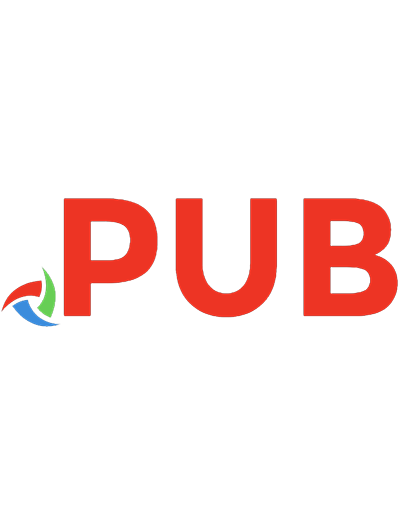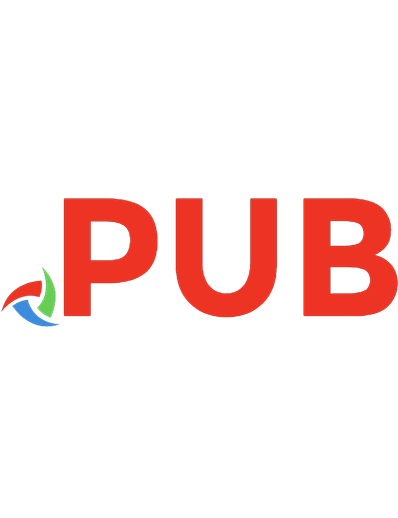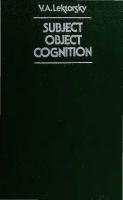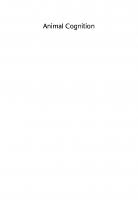Animal Cognition 9781137367297, 1137367296
Can animals think? How do pigeons find their way home? Do dogs feel guilt? Exploring animal behavior and intelligence, t
745 81 7MB
English Pages 0 [372] Year 2013
Polecaj historie
Table of contents :
Evolution, adaptation, cognition, and behavior : an introduction on minds, thought, and intelligence in animals --
Other ways of seeing the world --
Concept formation --
Time and number --
Cause and effect --
Reasoning --
Navigation --
Social cognition and self-awareness --
Social learning --
Remembering --
Animal communication in the wild --
Language --
Conclusion and comparisons.
Citation preview
Animal Cognition
Also by Clive D. L. Wynne Do Animals Think? (2004)
Anima
nition
Evolution, Behavior and Cognition
2nd edition Clive D. L. Wynne, Ph.D. Professor of Psychology, Arizona State University
Monique A. R. Udell, Ph.D. Assistant Professor of Animal Sciences, Oregon State University
pal grave •
First edition e Clive D. l. Wynne 2001 Second edition e Clive D. L. Wynne & Monique A R. Udell 2013 All rights reserved. No reproduction, copy or transmission of this publication may be made without written permission. No portion of this publication may be reproduced, copied or transmitted save with written permission or in accordance with the provisions of the Copyright, Designs and Patents Act 1988, or under the terms of any licence permitting limited copying issued by the Copyright Licensing Agency, Saffron House, 6-10 Kirby Street, London EC 1N 8TS. Any person who does any unauthorized act in relation to this publication may be liable to criminal prosecution and civil claims for damages. The authors have asserted their rights to be identified as the authors of this work in accordance with the Copyright, Designs and Patents Act 1988. First edition published 2001 Second edition published 2013 by PALGRAVE MACMILLAN Palgrave Macmillan in the UK is an imprint of Macmillan Publishers Limited, registered in England, company number 785998, of Houndmills, Basingstoke. Hampshire RG21 6XS. Palgrave Macmillan in the US is a division of St Martin's Press LLC, 175 Fifth Avenue, New York, NY 10010. Palgrave Macmillan is the global academic imprint of the above companies and has companies and representatives throughout the world. Palgrave• and Macmillan• are registered trademarks in the United States, the United Kingdom, Europe and other countries ISBN: 9784230-29422-{; hardback ISBN: 9784230-29423-3 paperback This book is printed on paper suitable for recycling and made from fully managed and sustained forest sources. Logging, pulping and manufacturing processes are expected to conform to the environmental regulations of the country of origin. A catalogue record for this book is available from the British Library. A catalog record for this book is available from the Library of Congress.
For my mother, and in memory of my father - Clive 0. L. Wynne For my parents, and my husband Chet - Monique A. R. Udell
This Page Intentionally Left Blank
Contents
List of Figures
XI
xv
Preface to the Second Edition Acknowledgements
XVII
Author Biographies
XXll
1
Evolution, Adaptation, Cognition, and Behavior: An Introduction
1
On Minds, Thought, and Intelligence in Animals
3
Historical Background: Darwin, Wallace, and the Minds of Beasts
4
A Cautionary Tale and a Canon
11
Clever Hans: the horse with the intelligence of a 14-year-old child
11
Lloyd Morgan's canon: the most awesome weapon in animal psychology
14
Now and the Future
14
Further Reading
15
Web sources 2
15
Other Ways of Seeing the World
17
Vision
18
The pigeon's eye view of the world: a case study in animal vision Patterns and pictures
23
Smell
27
Hearing
30
Magnetic sensitivity
32
Electric sense
34
Sensitivity to air pressure
35
Conclusions
35
Further Reading
36
Web sources 3
37
Concept Formation
39
Perceptual Concepts
40
Object Permanence
50
Relational Concepts
56
Same-different
57
Stimulus equivalence
59
Conclusions
62
Further Reading
62
Web sources 4
21
63
Time and Number
65
Time
66
Learning about time of day
66
Learning about short time intervals
68
Numbers
74
Relative number judgments: more or less
vii
74
viii
Contents Absolute number
76
Counting
78
Conclusions
85
Further Reading
85
Web sources 5
Cause and Effect Pavlovian Conditioning Pavlovian conditioning through the animal kingdom
91
What is learned in Pavlovian conditioning?
95 98
Outline
98
Learning from consequences
99
Instrumental conditioning throughout the animal kingdom
101
What is learned in instrumental conditioning?
105
Biological predispositions and roadblocks
109
Conclusions
112
Further Reading
115 115
Reasoning
117
Tool Use
117
Insight
121
Reasoning by Analogy
129
Series Learning I: Transitive Inference
130
Series Learning II: Linear Ordering
134
Fairness
135
Conclusions
137
Further Reading
138
Web sources Navigation Spatial Reasoning
139 141 141
Dead reckoning
142
Routes, landmarks, and beacons
144
The sun-compass
146
Cognitive maps and shortcuts
146
Case studies
152
Pigeon homing
152
Bees foraging
157
Distractions, side biases, and other considerations
160
Migration
163
Conclusions
168
Further Reading
169
Web sources 8
89 89
Web sources
7
87
Outline
Instrumental Conditioning
6
85
Social Cognition and Self-Awareness
169 171
Self-Recognition: Is That Me? - Studies on Mirror Recognition
172
Sensitivity to the Actions of Others
179
What Are You Looking At? Sensitivity to the Gaze of Others
187
Theory of Mind
190
Do You See What I See?
193
Conclusions
197
Further Reading
198
Web sources
198
Contents 9
Social Learning Social Influence Social facilitation Stimulus and local enhancement Affordance learning Social Learning: What Is It, Why Do It? Imitation - The Sincerest Form of Flattery True imitation Emulation Same end, different means Same means, different end Same means, competitive end Teaching Teaching in meerkats Teaching in ants Teaching in apes Conclusions Further Reading Web sources
10
Remembering Simple Memories Short-Term Memory Capacity Duration Serial order effects What causes forgetting? Long-Term Memory Food-storing birds Marsh tits and chickadees Nutcrackers Pigeons Implicit and Explicit Memory Metamemory - knowledge of what one remembers Episodic memory - what, when, and where Conclusions Further Reading Web sources
11
Animal Communication in the Wild The Dance of the Honeybee Chicken Alarm Calls Vervet Monkeys of Kenya Diana Monkeys Eavesdropping on Other Species' Signals Dolphins The Function and Evolution of Referential Calls Conclusions Further Reading Web sources
12
Language Ape Language Studies Words Sentences Kanzi
ix 201 201 202 203 205 206 211 212 216 217 217 220 221 223 224 225 226 228 228 231 232 234 237 237 239 242 245 245 245 247 249 252 252 253 255 256 256 259 262 267 268 269 270 273 274 274 274 277 278 278 287 289
x
Contents
Language Training with Other Species Communicating with Dolphins Irene Pepperberg and Alex Conclusions Further Reading Web sources
13
Conclusions and Comparisons Brain Size Learning Set Taking the Person Out of Animal Personality Are There Really Differences between Species? Further Reading Web sources
291 291 292 293 295 295 297 297 301 304 307 311 311
Notes
312
References
313
Index
339
List of Figures
1.1
Sand goby
1.2
Clever Hans with his trainer Mr. von Osten
2.1
Diagram of the electromagnetic spectrum showing human and
6 12 19
pigeon zones of sensitivity 2.2
View from above of the apparatus used by Delius and colleagues to assess pigeons' sensitivity to the polarization of light
21
2.3
Examples of the stimuli used by Reid and Spetch (1988)
24
2.4
Two representative displays used by Robert Cook
25
2. 5
A pigeon choosing between two objects in Spetch and Friedman's
(2006)
experiment
2.6
Resting orientations of cattle (A), roe deer (B), and red deer (C)
2. 7
Weakly electric African fish
3.1
Examples of stimuli readily classified by pigeons as fish (left) and
26 33 34
a picture commonly misclassified (right) in Herrnstein and de Villiers's experiment
3.2
43
Apparatus used by Bhatt and colleagues pigeons to classify each of
40
(1 988) to
train
pictures into one of four categories.
Note the four pecking keys, one at each corner of the screen showing the image
3.3
44
Images similar to those used in Aust and Huber's studies of the ability of pigeons to recognize pictures as real objects
3.4 3.5 3. 6 3.7 3.8
Two sample images from the experiment by Fersen and Lea One of Hanggi's horses choosing between a filled and an open sunlike stimulus
49
Gagnon and Dore's testing arena for dogs
51
A dog in Miller and colleagues' (2009) experiment
53
Apparatus used by Wright and colleagues to study pigeons' comprehension of the same-different concept
3.9
58
Design of Urcuioli and colleagues' (1989) stimulus equivalence experiment
60 69
4.1
Timing behavior of rufous hummingbirds
4 .2
The average rate of lever pressing for a group of rats accustomed to receiving food reward every
4 .3
40
seconds
71
Proportion of responses to the long key made by pigeons after stimuli of different durations
4.4
57
Performance of two groups of pigeons on a same different concept task
3.10
46 47
72
On the left, Rocky the raccoon is selecting the transparent cube containing an object in an early phase of training. On the right,
4.5 4.6
Rocky is receiving social reinforcement
76
One of Davis and Bradford's rats selecting the correct tunnel
78
Examples of stimuli used by Brannon and Terrace showing different numbers of various kinds of objects (the originals were colored)
xi
82
xii 4.7
Li st
of Figures
Sarah Boysen's chimp Sheba selecting the set of items that match the numeral shown on the screen
83
4.8
The room in which Sheba carried out the adding task
84
5.1
I. P. Pavlov (1849-1936)
90
5.2
Sketch of Aplysia showing siphon, mantle, and gill
92
5.3
The standard (left) and jumbled (right) groups from Rescorla's truly random control experiment
96
5.4
Design of Kamin's blocking experiment
97
5.5
An example of one of Thorndike's puzzle boxes
99
5.6
Consequences and outcomes of instrumental conditioning
100
5.7
Pigeon in an operant chamber
102
5.8
Rat in an operant chamber
103
5.9
T and radial mazes
103
5.10
Pigeons playing ping-pong
105
5.11
Rafiki's treatment analysis
108
6.1
Tool use of crows confronted with a familiar food bowl or novel stimuli in a food retrieval task
6.2
Grande completing Kohler's block stacking task while Sultan watches
6.3
6.5 6.6
123
A capuchin monkey pushing a pole into Visalberghi and Limongelli's 'trap tube' so as to obtain a candy
6.4
120
125
Six of the arrangements used by Hood and colleagues (1999) on the gravity task
126
string-pulling task
127
Simple (A) and more complex (B &. C) versions of the Illustration of the Pitcher and the Crow based on Aesop's tale, and a photograph of the real-world counterpart as reported by Christopher Bird and Nathan Emery (2009)
6.7
128
Examples of the items used to test Sarah's comprehension of analogy
130
7.1
A sketch based on Tinburgen's famous digger wasp experiment
145
7.2
A sketch of the maze used by Tolman and Honzik to study detour learning in rats
7.3
The mazes used in two stages of the experiment described by Tolman and colleagues
7.4
147 148
The triangular test area used by Chapuis and Varlet to test dogs' spatial reasoning ability
149
7.5
Homing of anosmic pigeons
155
7.6
Pigeons taken out on two routes return by two different paths
156
7.7
Experimental pigeons kept in a home aviary (left-hand diagram) through which an odor of benzaldehyde is blown by fans
157
7.8
Evidence that bees do not have a proper cognitive map
159
7.9
Barrier problem set by Kohler
160
7.10
One of the barrier problems used by Poucet et al.
162
7.11
Density of eggs and larva on milkweed plants after prescribed summer burning
7.12
164
Migration path of green turtles tracked by satellite from Redang Island in West Malaysia
167
8.1
A four-month-old dog looking at its image in a mirror
173
8.2
The experimental layout as described in Menzel et al. (1985)
178
8.3
The classic guilty look
182
8.4
Shifted developmental timing as a byproduct of domestication
185
List of Figures 8.5
xiii
In addition to dogs, bats, dolphins, and wolves are among a diverse group of species that have demonstrated the capacity to follow human points to a target in human-guided object-choice tasks.
8.6
186
A chimpanzee choosing between the container pointed to by the guesser and that pointed to by the knower
194
9.1
Imitation in ducks
204
9.2
A mouse eating from a jar containing the same flavor food that a demonstrator had consumed
206
9.3
Food consumption and muzzle sniffing in mice
207
9.4
A Japanese macaque washing potatoes in the ocean to get the sand off them
9.5
Based on Heyes and Dawson's (1 990) setup for the bidirectional control procedure
9.6
210 213
Young chimpanzee solving an opaque (a) and transparent (b) version of a puzzle box in a study conducted by Victoria Horner and Andrew Whiten (2005)
216
An elephant performing the same behavior as the human trainer
219
10.1
A stentor
233
10.2
A rat in a water maze
235
10.3
The delayed matching to sample procedure
236
10.4
The layout used by Spetch and Honig to study pigeons'
9.7
memory for locations in a room
238
10.5
Serial order effect in monkeys
240
10.6
The environment in which Sherry and colleagues studied how birds rely on global cues to remember where they have stored food
10.7
The arena used by Vander Wall to test nutcrackers' memory of stored seed positions
10.8
247 248
A selection of the stimuli used by Fersen and Delius in their study of pigeons' rote memorization ability
250
11.1
Darwin's dog Polly 'watching a cat on a table'
261
11.2
The round (left) and waggle (right) dances of the honeybee
262
11.3
Each line represents the flight path of a bee that attended to the waggle dance of a bee that started at the hive and found its way to the feeder. The diamond release points at the bottom left of the figure are where bees that were attempting to fly out of the hive were shifted to and then released. It can be seen that they fly out of the release points in the approximate direction and distance of the feeder
264
11.4
Sonograms of white-crowned sparrow song
266
11.5
Experimental arrangement for Evans and Marler's experiments on
12. l
communication in chickens
267
Nim signing 'Me hug cat' to a human trainer
280
12.2
Lana operating a Yerkish keyboard
281
12.3
Growth of Nim's vocabulary over a 32-week period compared with that of a child just after her second birthday
282
12.4
Chaser on top of a pile of all the toys she knows the names of
283
12.5
Growth of Chaser's vocabulary
284
12.6
Change in length of utterance for Nim, a deaf child, and a hearing child
287
12.7
Some of the commands used to train Akeakamai
292
13.1
Brain mass against body mass for several different
13.2
species of vertebrates
298
Cephalization indexes of several species
299
xiv
13.3 13.4
List of Figures Human brain compared with that of a reptile, fish, bird, and rat Percentages of correct responses on trial
2
300
of different discrimination
problems plotted against successive problem number for
13.5 13.6
several different species
302
36 successive problems
303
Owner's ratings of the emotions they believe their pets display
306
Picture of dunnart next to trial 2 performance on
Preface to the Second Edition
It has bee11 over a decade since the first edition ofAnimal Cognition appeared, and a lot has happened i11 the sciences of a11imal behavior and cognitio11 in that tin1e. Ten years ago, nobody guessed that a dog \.VOuld be found that knew the names of over a thousand objects (n1eet Chaser i11 Chapter 12) or that a crow would be fou11d on a South Pacific isla11d that could create tools out of pieces of wire (n1eet Betty in Chapter 6). Son1e people 1night have suspected that evidence of culture would be found in chi1npanzees (see Chapter 9) and that pigeons would sho\.v that they can generalize fro1n experience of pictures of people with 110 heads to pictures of heads \.Vithout bodies (Chapter 3) - these latter two discoveries n1ay not be as surprising, but they are 11onetheless fascinati11g. The 2000s \



![Animal Thinking : Contemporary Issues in Comparative Cognition [1 ed.]
9780262298988, 9780262016636](https://dokumen.pub/img/200x200/animal-thinking-contemporary-issues-in-comparative-cognition-1nbsped-9780262298988-9780262016636.jpg)
![Animal Minds: Beyond Cognition to Consciousness [Revised and expanded]
0226308650, 9780226308654](https://dokumen.pub/img/200x200/animal-minds-beyond-cognition-to-consciousness-revised-and-expanded-0226308650-9780226308654.jpg)




